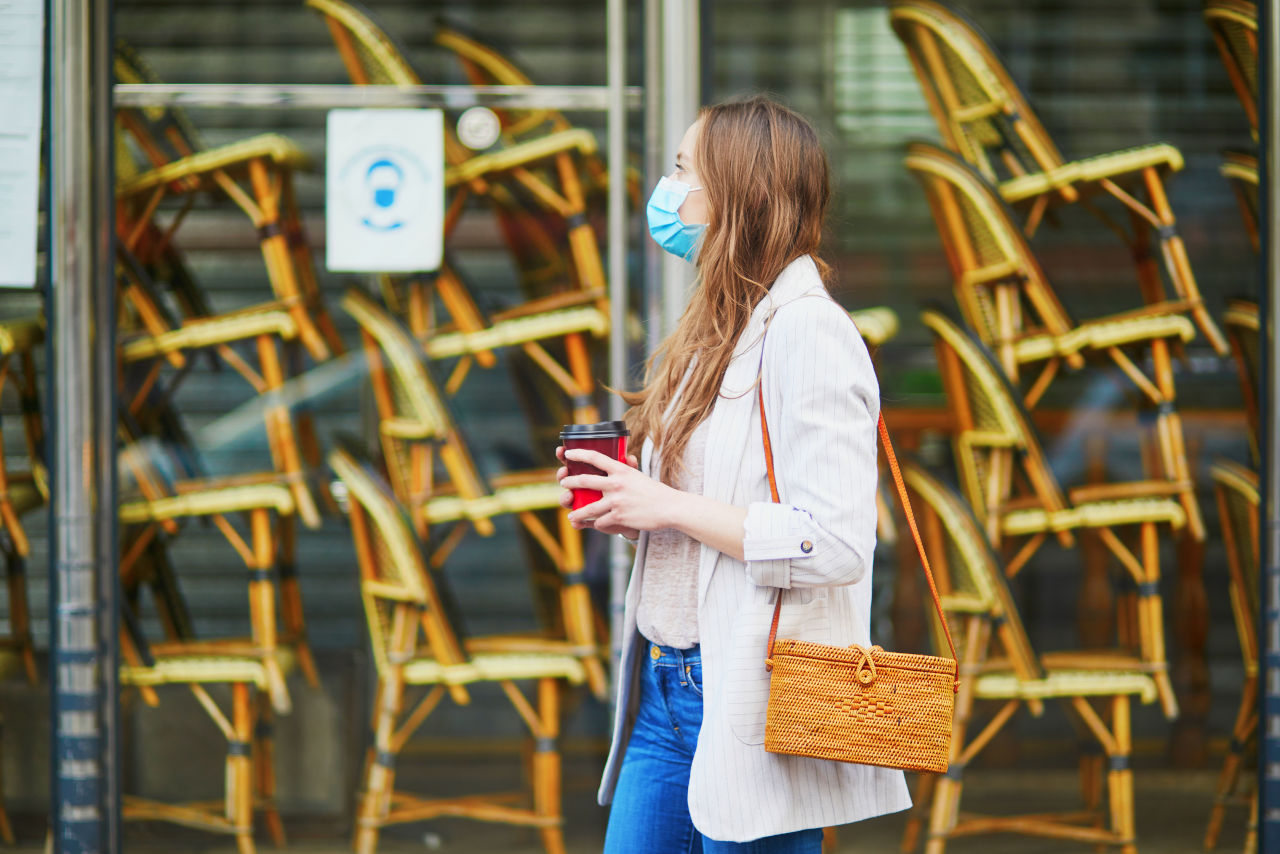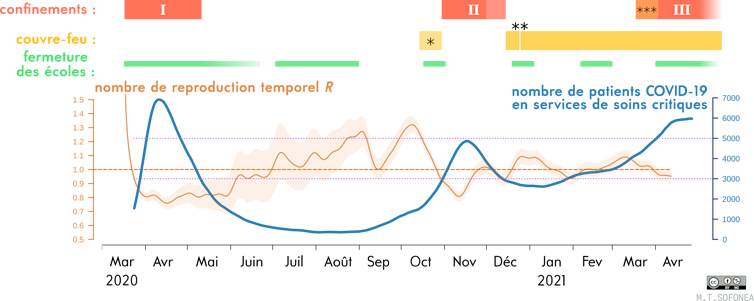Conversation with Mircea Sofonea: "In France, control of the epidemic is still fragile".
Since May 3, we've been in the first phase of a four-phase deconfinement process. With the second phase, starting on May 19, restaurants, terraces, cultural venues and sports facilities should be included. On the eve of these reductions, what's the latest on the epidemic situation?
Mircea T. Sofonea, University of Montpellier

What can we expect from its evolution, and what impact could it have on hospital tension? Answers from Mircea Sofonea, Senior Lecturer in Epidemiology and Evolution of Infectious Diseases at the University of Montpellier.
The Conversation: We've had three confinements in one year. How does this latest episode compare with the previous ones?
Mircea Sofonea: Based on hospital data and genetic analysis of samples collected in our country, it would appear that the first wave of the Covid-19 epidemic in France began in the second half of January 2020.
In the spring of the same year, an initial eight-week hard lockdown reduced the number of new cases to 4,000 per day by the time the lockdown was lifted. France then experienced a lull over the summer, before suffering a second wave in the autumn, leading to a second national containment in October 2020 - even though the benefits of early, territorialized measures had already been well documented. The intensity and duration of this second containment were not sufficient to bring the incidence back below 5,000 new cases (detected) per day - not least because viral circulation among children was underestimated, and because of the lighter holiday season.
Also read:
What do we know about the role of schools in the Covid-19 epidemic? Five experts respond
From then on, the executive opted for a different strategy to that of its neighbors in managing the epidemic, tolerating substantial circulation of the virus, accompanied by a high level of hospital occupancy. In addition to this intermediate level of control, social restrictions such as curfews were maintained. This choice was motivated by the hope that there might have been a "mouse hole" into which to slip to minimize both the economic and health impact at every moment of the epidemic. A chimerical hope, as subsequent events have shown.

Sofonea M. T., et al (2021) Anaesthesia Critical Care & Pain Medicine, Author provided
This strategy was continued in early 2021, despite the arrival of the more contagious "British" variant, whose dynamics were documented relatively early on. As a result, a third national lockdown had to be instituted on April 3. Schools were closed for 3 weeks (including two school vacations) and relative freedom of movement was maintained.
TC: Did this third containment achieve its objectives?
MS: As we recall in an article recently published in Anaesthesia Critical Care & Pain Medicine (official journal of the Société Française d'Anesthésie et de Réanimation), containment has two objectives: to cap hospital occupancy in order to avoid a deterioration in care, and to regain control of the epidemic by minimizing incidence, in other words by reducing the number of new cases per day to a level low enough to be maintained by an intensive strategy of screening, tracing and isolation.
Arriving late, this third containment was not as effective as the previous two (due in particular to the over-contagiousness of the majority circulating variant, B.1.1.7). It was also relatively short. As we know, the longer we wait before taking action, the higher the levels of virus circulation and hospital occupancy, and the longer we have to wait to return to acceptable levels in terms of epidemic control (low incidence, low hospital occupancy). By the end of the second decontainment, hospital occupancy levels, particularly in critical care departments - which had been in constant demand and stress for 14 months - had not returned to the same low levels as during the first decontainment.
This new confinement has achieved its first objective - to cap hospital occupancy: currently, there are around 5,600 Covid patients in public care intensive care units.
On the other hand, the second objective has not really been achieved: the reproduction number calculated three weeks after the start of the third containment was around 0.95 - but it has since fallen(editor's note: also known as "effective R", the reproduction number is an estimate, over the last 7 days, of the average number of individuals contaminated by an infected person). After the first containment, this number had fallen to around 0.8 within 2 weeks - kinetically speaking, the epidemic decline in the first two weeks of the third containment was therefore more than three times slower.
Under these conditions, we would have to wait several more weeks to return to a level of 3,000 new cases per day, as was the case during the first decontamination a year ago.
TC: The announcements concerning the release of this third containment have been made. What could happen now, according to your models?
MS: In a way, the epidemic trajectory taken by the country since October has led to a kind of impasse.
On the one hand, epidemic control is still too fragile and relies heavily on individual responsibility. On the other hand, we all want to get back to our habits, our pre-pandemic lives, we're weary if not exasperated by restrictions, and even maintaining them could be met with rejection and circumvention.
The only prospect, then, seems to be acceptance of the morbidity and mortality toll caused by a third, slowly receding wave. For it should be remembered that the health stakes are not limited to deaths due to Covid (too often used as the sole quantifier), but also to quality of life after resuscitation, long Covids and pathologies whose diagnosis and management have been delayed by deprogramming following the rise of the third wave (in Île-de-France and Hauts de France in particular).
TC: But this time, vaccination is available. And the good times are coming...
Vaccination coverage is fortunately having a significant effect, but its level is not yet sufficient to halt the epidemic on its own. According to our model, which takes into account the increased transmission of variants, but not potential immune escape, to achieve herd immunity, vaccination coverage would have to reach 70% of the population (i.e. over 90% of the adult population), but at present we're at 25% for the first dose.
As far as fine weather is concerned, it can be favorable to a reduction in transmission, as long as it is accompanied by a preferential outdoor lifestyle and constantly ventilated homes. However, if we look at the history of reproduction numbers since the introduction of the first confinement, we can see that there have been two peaks of contagiousness with reproduction numbers above 1.3: in August and October. Once again, summer weather is no guarantee of absolute control.
During convivial events, even if most of the time is spent outdoors, a transient concentration in an unmasked interior (kitchen) remains an opportunity for transmission. Crowded terraces where people talk loudly (over background noise), shoulder to shoulder, also expose us to infectious aerosols, even if they are diluted much more rapidly than indoors.
Finally, the dynamic of the weeks ahead will once again depend on our collective respect for barrier gestures, combined with the triptych test-trace-isolate.
TC: With all these uncertainties, how do you assess what might happen?
MS: It's very difficult to make forecasts beyond two weeks, given the uncertainties surrounding the synergy of the various measures. We can, however, use previous deconfinements to explore scenarios, which then give rise to projections dependent on assumptions.
In the first case, if the contact rate (the number of person-to-person contacts per unit of time) were similar to October's, incidence would rise slightly before beginning a slow descent, mainly thanks to increased vaccination coverage. In this scenario, the number of patients in intensive care would not fall below 4,000 until July.

Sofonea M. T., et al (2021) Anaesthesia Critical Care & Pain Medicine, Author provided
In the second scenario, if the contact rate were even 10% higher than in October, the epidemic could rebound, once again exposing intensive care units to high levels of stress, as early as mid-June, after having reached a low point at the end of May, at around 5,000 critical care patients.
TC: How did the other countries that were most successful in controlling the epidemic proceed?
MS: The countries that fared best did everything they could to bring the epidemic under control as soon as possible, and then returned to normal life: this is the case of South Korea, New Zealand and Taiwan, for example. However, it cannot be denied that they benefited from more favorable conditions.
Compared with other countries that have aimed for elimination, France has, since last summer, chosen to minimize the number of containment periods rather than the number of containment days, resulting in a sub-optimal stop-and-go approach that has not minimized virus circulation. It's better to have more confinements, but short and territorialized, as the New Zealanders did in Auckland (or the Chinese in Beijing, for example), to break transmission chains at a very early stage.
What's more, by not sharply reducing incidence before relying on vaccine coverage to control the epidemic (as the UK, Portugal and Denmark, for example, have done), the possibility of local rebounds in early summer cannot be ruled out in France. Another disadvantage of vaccinating at a time of high incidence (when viral diversity is naturally greater) is that there is a greater risk of the emergence of variants that are better able to circumvent natural or vaccine immunity. If we vaccinate when the virus is circulating very little, this risk is lower.![]()
Mircea T. Sofonea, Senior Lecturer in Epidemiology and Evolution of Infectious Diseases, MIVEGEC Laboratory, University of Montpellier
This article is republished from The Conversation under a Creative Commons license. Read theoriginal article.